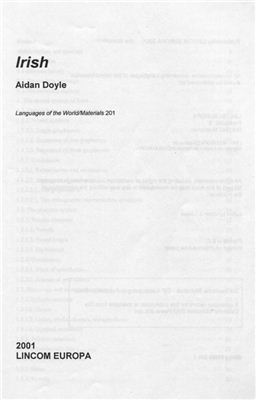Lincom Europa, 2001. - 105 p.
This book offers a concise presentation of the main features of Mode Irish. The first chapter contains a brief historical survey of the language, and discusses the present sociolinguistic situation. The next three chapters are conceed with the sound-system of Irish, its morphology, and its syntax, and the book concludes with two sample texts, accompanied by a phonetic transcription and interlinear translation.
In the chapter on phonology, the question of morphophonological alteations is discussed in detail: these include variation in the quality and quantity of vowels, shifts in stress, and initial mutations. In the chapter on morphology, particular attention is paid to the morphosyntactic use of initial mutations, numerous paradigms being provided of the effect exerted by various particles on the major lexical categories of Irish. One section is devoted to derivational morphology, an aspect of the language which has been neglected in past studies.
The approach to syntax is novel. Rather than merely cataloguing the various traditional sentence pattes found in Irish, the author focusses on those aspects which are of relevance to current syntactic research in general. All three chapters contain a comprehensive and up-to-date range of references for further reading.
This study will be of interest both to general linguists with no previous knowledge of Irish, and also to lecturers and students of Celtic studies interested in language.
The author, a lecturer in linguistics at the University of Gdansk, has written on various aspects of the Irish language. Other publications include a handbook and a reverse dictionary of Mode Irish, and a number of articles conceed with morphology and syntax.
This book offers a concise presentation of the main features of Mode Irish. The first chapter contains a brief historical survey of the language, and discusses the present sociolinguistic situation. The next three chapters are conceed with the sound-system of Irish, its morphology, and its syntax, and the book concludes with two sample texts, accompanied by a phonetic transcription and interlinear translation.
In the chapter on phonology, the question of morphophonological alteations is discussed in detail: these include variation in the quality and quantity of vowels, shifts in stress, and initial mutations. In the chapter on morphology, particular attention is paid to the morphosyntactic use of initial mutations, numerous paradigms being provided of the effect exerted by various particles on the major lexical categories of Irish. One section is devoted to derivational morphology, an aspect of the language which has been neglected in past studies.
The approach to syntax is novel. Rather than merely cataloguing the various traditional sentence pattes found in Irish, the author focusses on those aspects which are of relevance to current syntactic research in general. All three chapters contain a comprehensive and up-to-date range of references for further reading.
This study will be of interest both to general linguists with no previous knowledge of Irish, and also to lecturers and students of Celtic studies interested in language.
The author, a lecturer in linguistics at the University of Gdansk, has written on various aspects of the Irish language. Other publications include a handbook and a reverse dictionary of Mode Irish, and a number of articles conceed with morphology and syntax.

